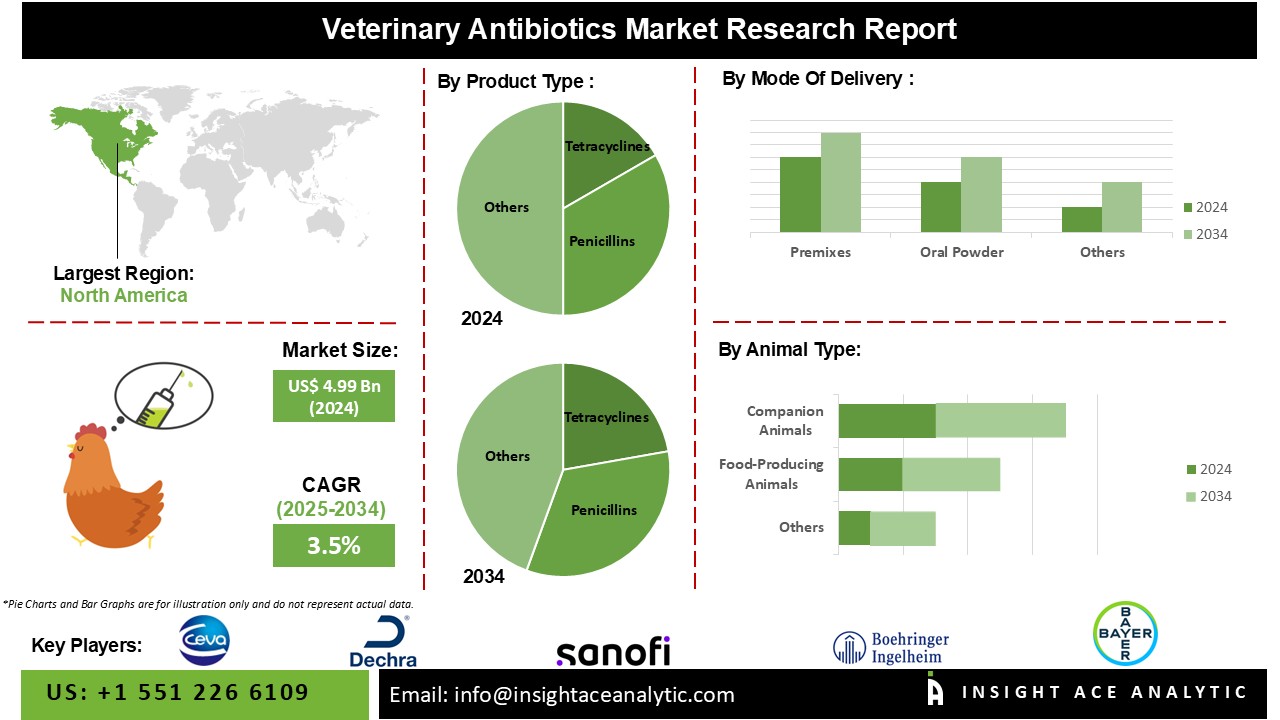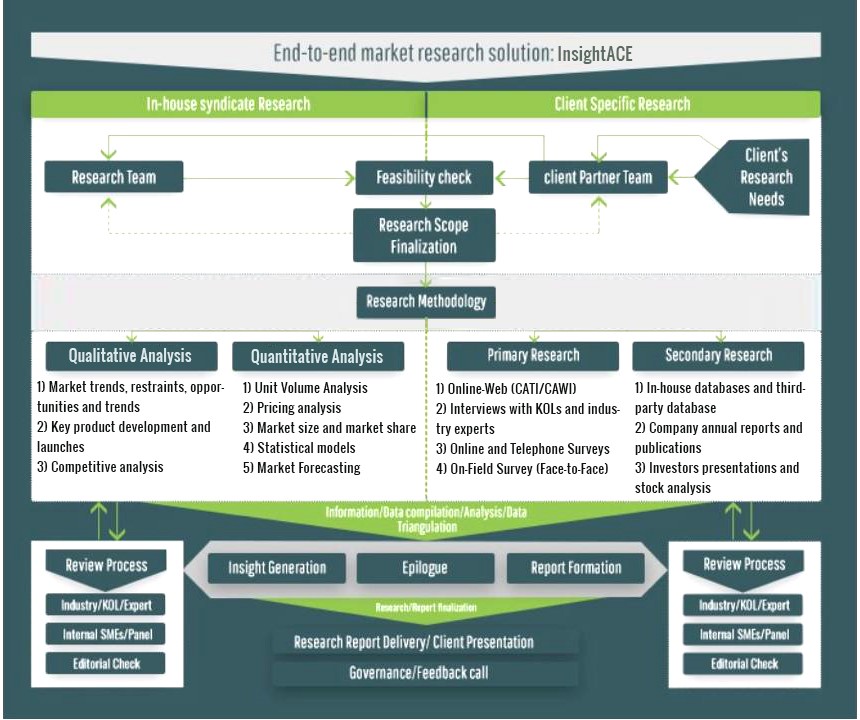Veterinary Antibiotics Market Size is valued at USD 4.99 Billion in 2024 and is predicted to reach USD 6.95 Billion by the year 2034 at a 3.5 % CAGR during the forecast period for 2025-2034.

Key Industry Insights & Findings from the Report:
Antibiotics can be used to treat a single animal with clinical disease or a large group of animals. In many countries, antibiotics are commonly added to commercial feed for growth promotion in chickens. Antibiotics have effectively improved the rate and efficiency of gain in swine, cattle, and poultry. The different applications of antibiotics in food animals have been described as therapeutic use, prophylactic use, and subtherapeutic use. The global Veterinary antibiotics market is driven by end-use verticals consisting of dairy, meat industry applications. The increasing consumer preference for various dairy products and the rise in companion animal ownership is expected to increase the demand. Increasing animal disease outbreaks and increasing initiatives concerning animal health and welfare is anticipated to further strengthen its demand over the forecast period.
The Global Veterinary Antibiotics market is categorized on the basis of Product Type, Mode Of Delivery, Animal Type, and region. On the basis of Product Type, the market is segmented into Tetracyclines, Penicillins, Sulfonamides, Macrolides, Aminoglycosides, Lincosamides, Fluoroquinolones, Other Antimicrobials and Antibiotics. Based on Mode of delivery, the market is segmented into Premixes, Oral Powder, Oral Solution, Injection, and Others. Whereas Animal type segment includes Food-Producing Animals (Cattle, Pigs, Poultry, Sheep and Goats, Other Food-producing Animals) and Companion Animals (Dogs, Cats, Horses, Other Companion Animals). Based on region, the market is studied across North America, Asia-Pacific, Europe, and LAMEA. On the other hand, North America is expected to dominate the market during the analysis of the forecast period.
|
Report Attribute |
Specifications |
|
Market Size Value In 2024 |
USD 4.99 Billion |
|
Revenue Forecast In 2034 |
USD 6.95 Billion |
|
Growth Rate CAGR |
CAGR of 3.5% from 2025 to 2034 |
|
Quantitative Units |
Representation of revenue in US$ Million and CAGR from 2025 to 2034 |
|
Historic Year |
2021 to 2024 |
|
Forecast Year |
2025-2034 |
|
Report Coverage |
The forecast of revenue, the position of the company, the competitive market structure, growth prospects, and trends |
|
Segments Covered |
By Product Type, By Mode Of Delivery, By Animal Type |
|
Regional Scope |
North America; Europe; Asia Pacific; Latin America; Middle East & Africa |
|
Country Scope |
U.S.; Canada; U.K.; Germany; China; India; Japan; Brazil; Mexico; The UK; France; Italy; Spain; South Korea; South East Asia |
|
Competitive Landscape |
Bayer AG, Boehringer Ingelheim GmbH, Ceva Sante Animale S.A., Crystal Pharma, Dechra Pharmaceuticals PLC, Huvepharma AD, Eli Lilly Company, Elanco, Merck & Co., Inc., Sanofi S.A., Vetoquinol S.A., Virbac, Zoetis, Inc., Inovet Group, Dopharma, and Others |
|
Customization Scope |
Free customization report with the procurement of the report, Modifications to the regional and segment scope. Particular Geographic competitive landscape. |
|
Pricing and Available Payment Methods |
Explore pricing alternatives that are customized to your particular study requirements. |
Chapter 1. Methodology and Scope
1.1. Research Methodology
1.2. Research Scope & Assumptions
Chapter 2. Executive Summary
Chapter 3. Global Veterinary Antibiotics Market Snapshot
Chapter 4. Global Veterinary Antibiotics Market Variables, Trends & Scope
4.1. Market Segmentation & Scope
4.2. Drivers
4.3. Challenges
4.4. Trends
4.5. Investment and Funding Analysis of Key Veterinary Companies
4.6. Industry Analysis – Porter’s Five Forces Analysis
4.7. Competitive Landscape & Market Share Analysis
4.8. Major Investment, Partnerships and Collaborations in Veterinary Research
Chapter 5. Market Segmentation 1: Product Type Estimates & Trend Analysis
5.1. Product Type & Market Share, 2019 & 2031
5.2. Market Size (Value US$ Mn) & Forecasts and Trend Analyses, 2019 to 2031 for the following Product Type:
5.2.1. Tetracyclines
5.2.2. Penicillins
5.2.3. Sulfonamides
5.2.4. Macrolides
5.2.5. Aminoglycosides
5.2.6. Lincosamides
5.2.7. Fluoroquinolones
5.2.8. Cephalosporins
5.2.9. Other Antimicrobials and Antibiotics
Chapter 6. Market Segmentation 2: Mode of Delivery Estimates & Trend Analysis
6.1. Mode of Delivery & Market Share, 2019 & 2031
6.2. Market Size (Value US$ Mn) & Forecasts and Trend Analyses, 2019 to 2031 for the following Mode of Delivery:
6.2.1. Premixes
6.2.2. Oral Powder
6.2.3. Oral Solution
6.2.4. Injection
6.2.5. Others
Chapter 7. Market Segmentation 3: Animal Type Estimates & Trend Analysis
7.1. Animal Type & Market Share, 2019 & 2031
7.2. Market Size (Value US$ Mn) & Forecasts and Trend Analyses, 2019 to 2031 for the following Animal Type
7.2.1. Premixes
7.2.2. Oral Powder
7.2.3. Oral Solution
7.2.4. Injection
7.2.5. Others
Chapter 8. Veterinary Antibiotics Market Segmentation 4: Regional Estimates & Trend Analysis
8.1. North America
8.1.1. North America Veterinary Antibiotics Market revenue (US$ Million) estimates and forecasts by Product Type, 2024-2031
8.1.2. North America Veterinary Antibiotics Market revenue (US$ Million) estimates and forecasts by Mode of Delivery, 2024-2031
8.1.3. North America Veterinary Antibiotics Market revenue (US$ Million) estimates and forecasts by country, 2024-2031
8.2. Europe
8.2.1. Europe Veterinary Antibiotics Market revenue (US$ Million) by Product Type, 2024-2031
8.2.2. Europe Veterinary Antibiotics Market revenue (US$ Million) by Mode of Delivery, 2024-2031
8.2.3. Europe Veterinary Antibiotics Market revenue (US$ Million) by country, 2024-2031
8.3. Asia Pacific
8.3.1. Asia Pacific Veterinary Antibiotics Market revenue (US$ Million) by Product Type, 2024-2031
8.3.2. Asia Pacific Veterinary Antibiotics Market revenue (US$ Million) by Mode of Delivery, 2024-2031
8.3.3. Asia Pacific Veterinary Antibiotics Market revenue (US$ Million) by country, 2024-2031
8.4. Latin America
8.4.1. Latin America Veterinary Antibiotics Market revenue (US$ Million) by Product Type, (US$ Million) 2024-2031
8.4.2. Latin America Veterinary Antibiotics Market revenue (US$ Million) by Mode of Delivery, 2024-2031
8.4.3. Latin America Veterinary Antibiotics Market revenue (US$ Million) by country, (US$ Million) 2024-2031
8.5. Middle East & Africa
8.5.1. Middle East & Africa Veterinary Antibiotics Market revenue (US$ Million) by Product Type, (US$ Million) 2024-2031
8.5.2. Middle East & Africa Veterinary Antibiotics Market revenue (US$ Million) by Mode of Delivery, (US$ Million) 2024-2031
8.5.3. Middle East & Africa Veterinary Antibiotics Market revenue (US$ Million) by country, (US$ Million) 2024-2031
Chapter 9. Competitive Landscape
9.1. Major Mergers and Acquisitions/Strategic Alliances
9.2. Company Profiles
9.2.1. Bayer AG
9.2.2. Boehringer Ingelheim GmbH
9.2.3. Ceva Sante Animale S.A.
9.2.4. Crystal Pharma
9.2.5. Dechra Pharmaceuticals PLC
9.2.6. Huvepharma AD
9.2.8. Eli Lilly Company
9.2.8. Elanco
9.2.9. Merck & Co., Inc.
9.2.10. Sanofi S.A.
9.2.11. Vetoquinol S.A.
9.2.12. Virbac
9.2.13. Zoetis, Inc.
9.2.14. Inovet Group
9.2.15. Dopharma
9.2.16. Other Prominent Players
Global Veterinary Antibiotics Market by Product Type
Global Veterinary Antibiotics Market by Mode of Delivery
Global Veterinary Antibiotics Market by Animal Type
Global Veterinary Antibiotics Market Based on Region
Europe
North America
Asia Pacific
Latin America
Middle East & Africa
InsightAce Analytic follows a standard and comprehensive market research methodology focused on offering the most accurate and precise market insights. The methods followed for all our market research studies include three significant steps – primary research, secondary research, and data modeling and analysis - to derive the current market size and forecast it over the forecast period. In this study, these three steps were used iteratively to generate valid data points (minimum deviation), which were cross-validated through multiple approaches mentioned below in the data modeling section.
Through secondary research methods, information on the market under study, its peer, and the parent market was collected. This information was then entered into data models. The resulted data points and insights were then validated by primary participants.
Based on additional insights from these primary participants, more directional efforts were put into doing secondary research and optimize data models. This process was repeated till all data models used in the study produced similar results (with minimum deviation). This way, this iterative process was able to generate the most accurate market numbers and qualitative insights.

Secondary research
The secondary research sources that are typically mentioned to include, but are not limited to:
The paid sources for secondary research like Factiva, OneSource, Hoovers, and Statista
Primary Research:
Primary research involves telephonic interviews, e-mail interactions, as well as face-to-face interviews for each market, category, segment, and subsegment across geographies
The contributors who typically take part in such a course include, but are not limited to:
Data Modeling and Analysis:
In the iterative process (mentioned above), data models received inputs from primary as well as secondary sources. But analysts working on these models were the key. They used their extensive knowledge and experience about industry and topic to make changes and fine-tuning these models as per the product/service under study.
The standard data models used while studying this market were the top-down and bottom-up approaches and the company shares analysis model. However, other methods were also used along with these – which were specific to the industry and product/service under study.
To know more about the research methodology used for this study, kindly contact us/click here.